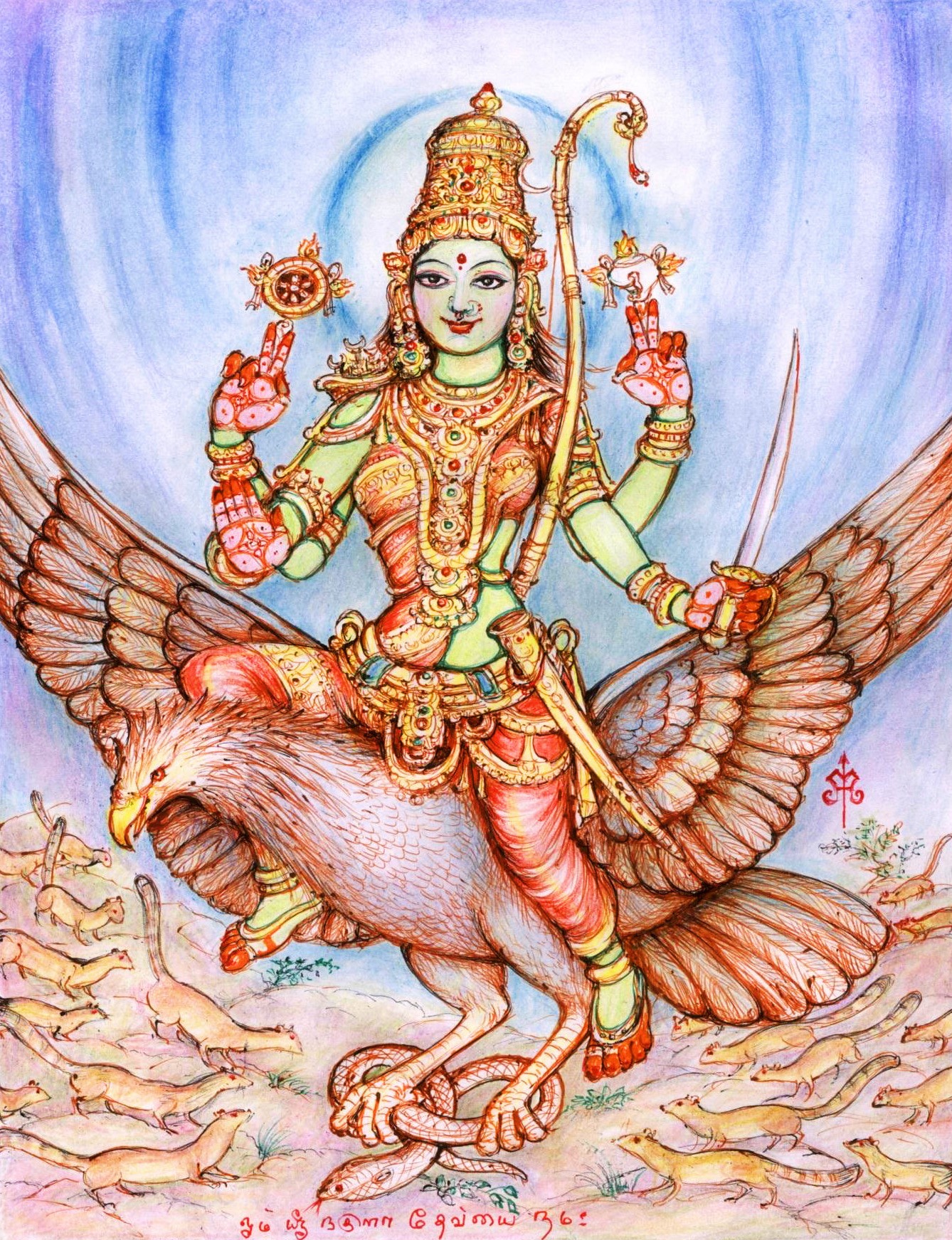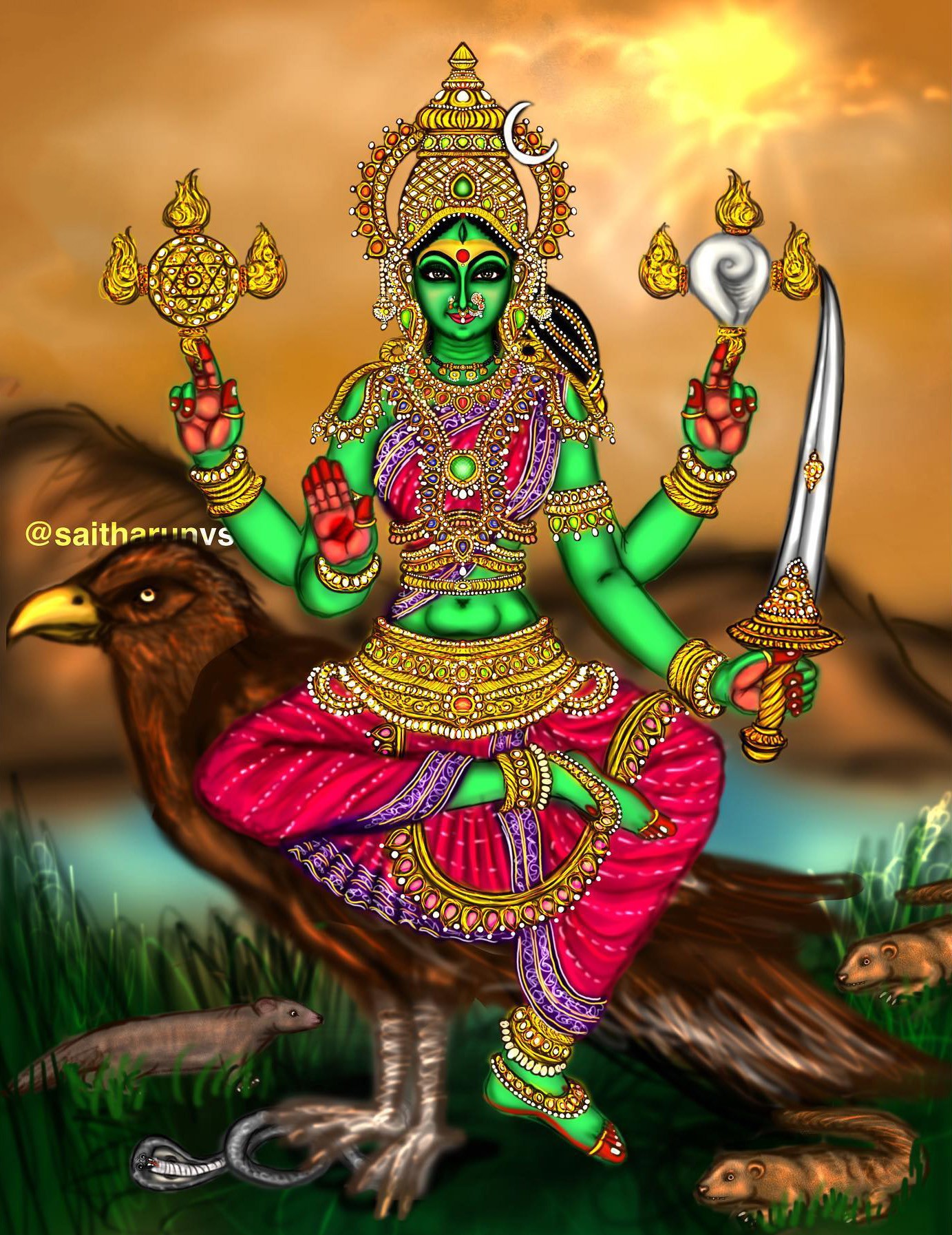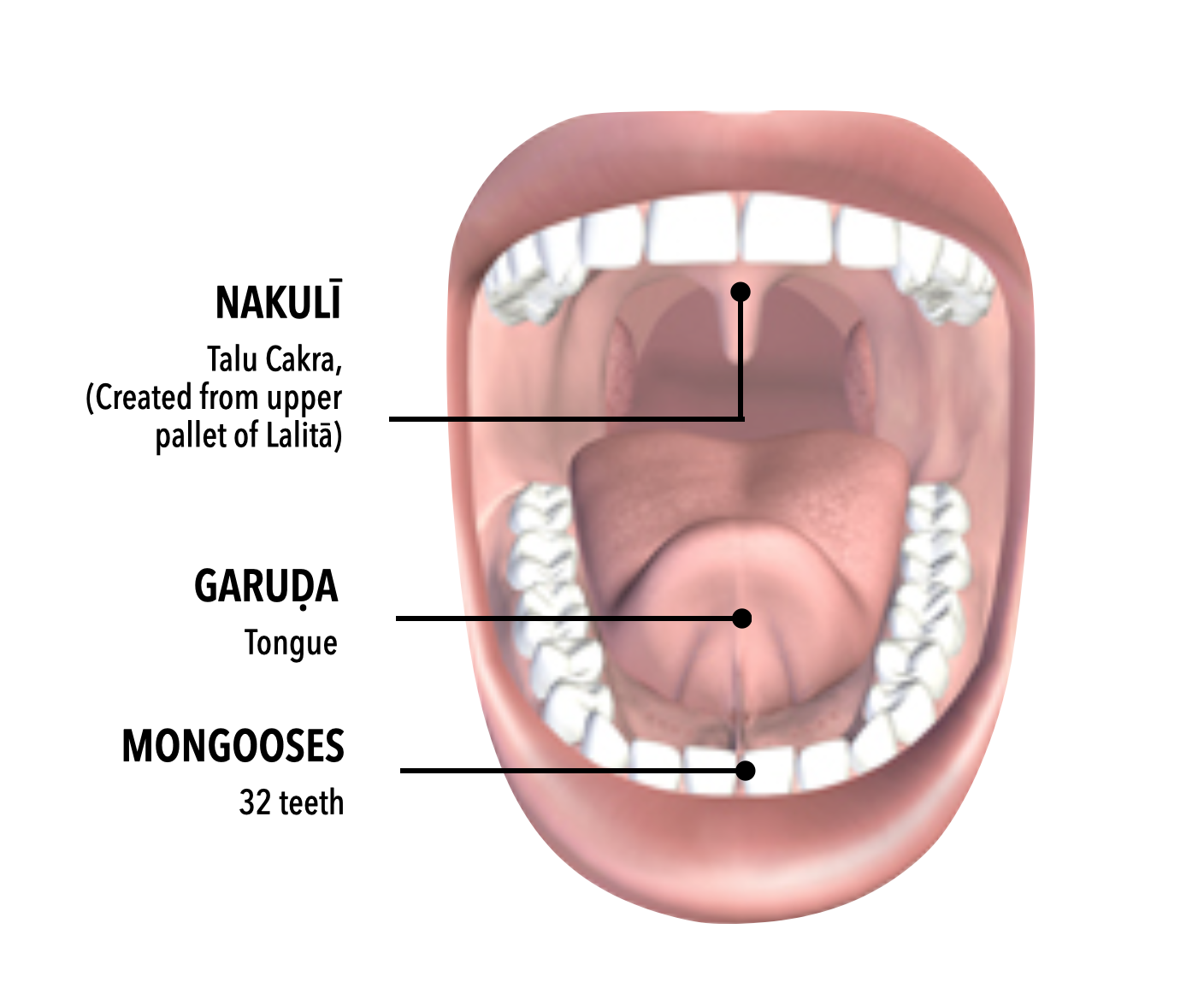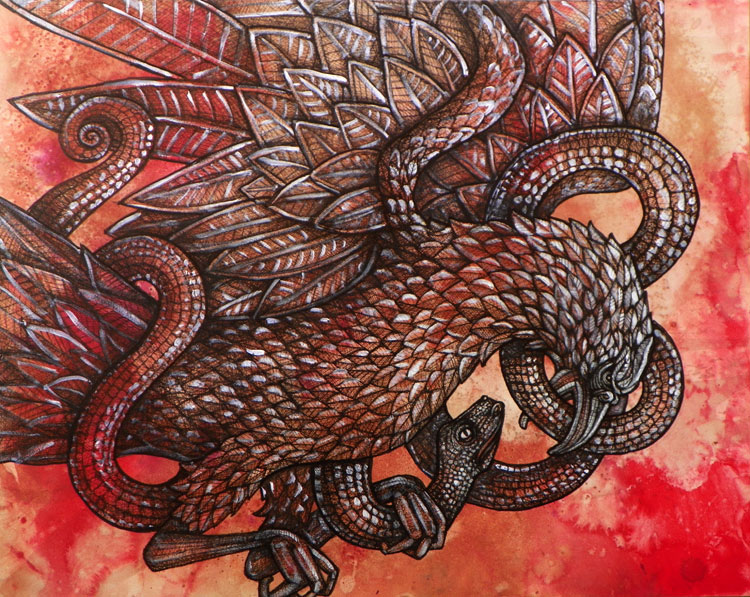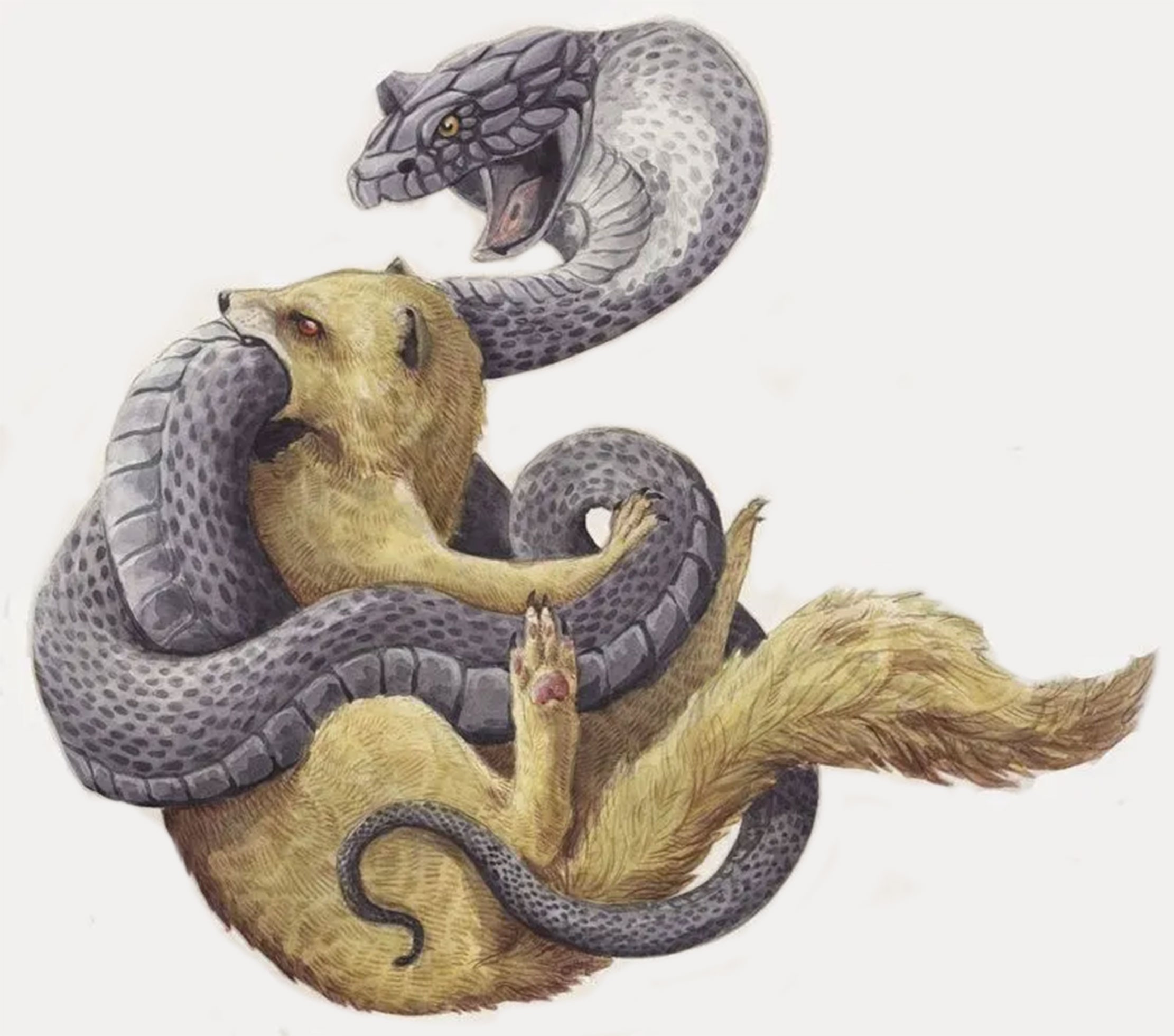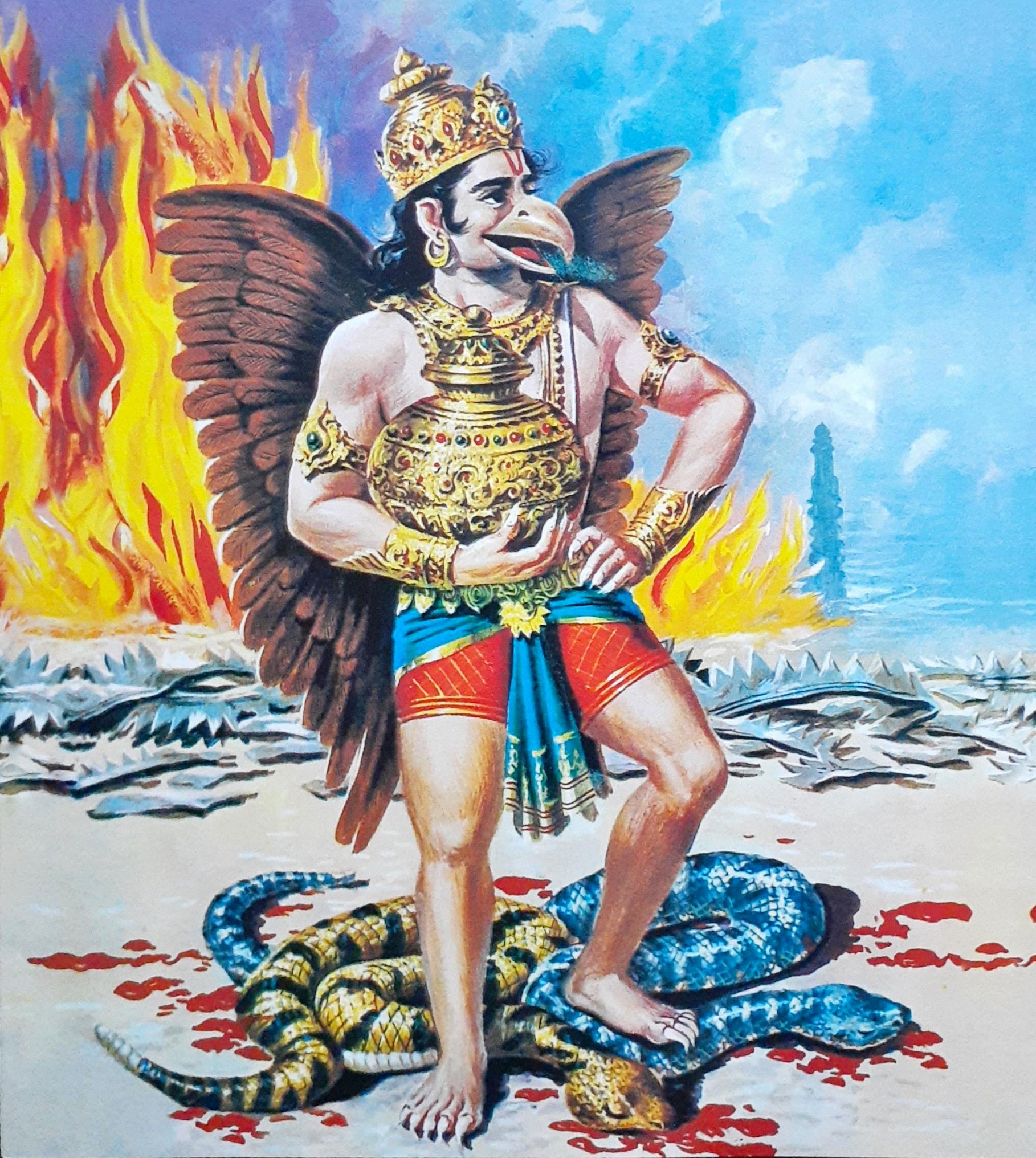The Story of Nakulī (Pratyaṅga Devata of Rāja Śyāmalā) from Lalitopakhyana
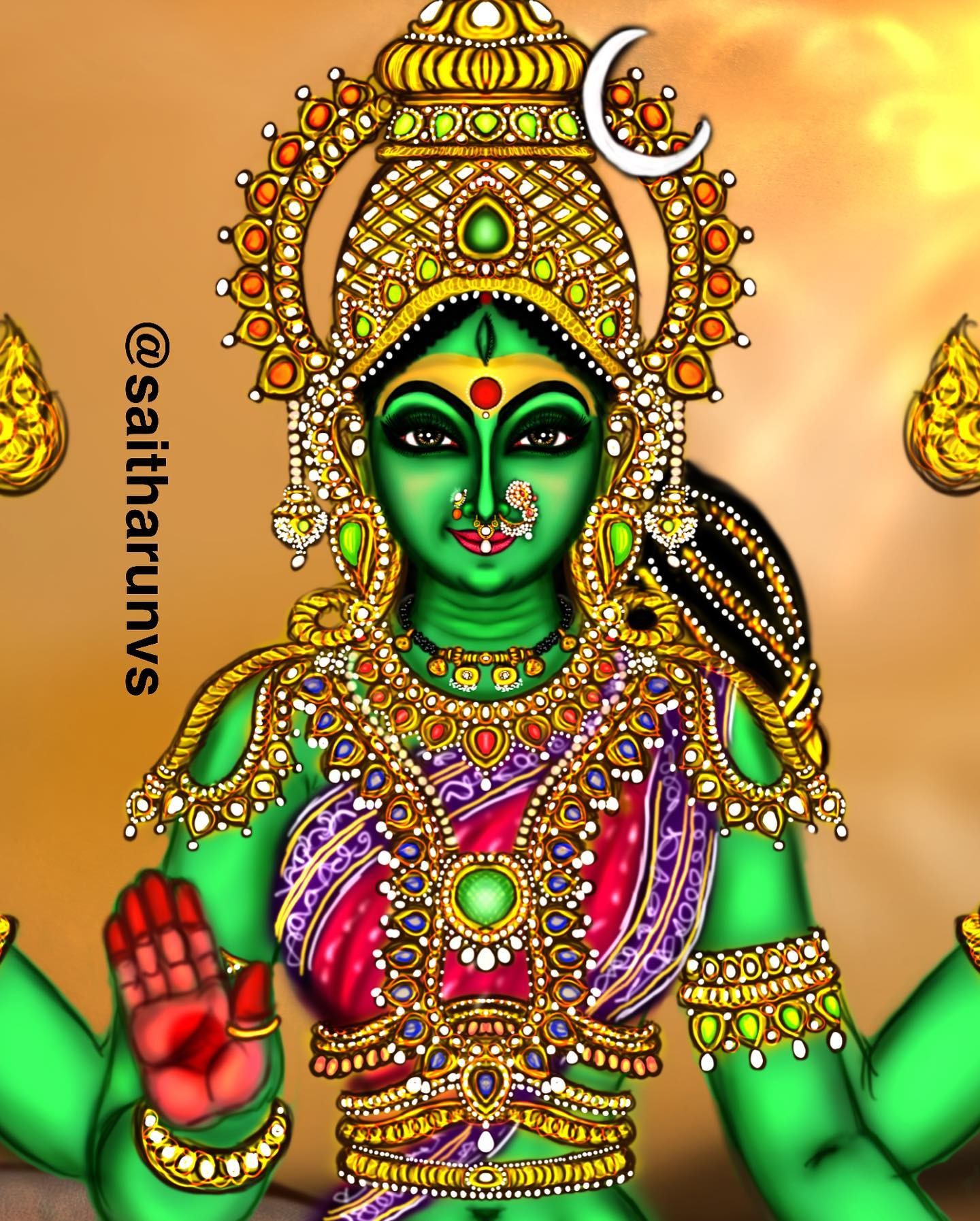
Chapter 23: Five Asura Generals Slain.
Hayagrīva continued:
1. When Kuraṇḍa was thus slain by the Goddess seated on the horse, the demon Bhaṇḍa said to Kuṭilākṣa once again in his eager desire for war.
2. “Alas! What could not have occurred even in a dream, what has never been heard before, what has not even been suspected by us in our minds —such a calamity has befallen us.
3. Kuraṇḍa and Durmada had been very mighty brothers. The power of this wicked fraudulent female slave (practitioner of black magic) is greater than we expected.
4. Now despatch five of our generals beginning with Karaṅka along with a hundred Akṣauhiṇīs to the battle-field.
5. They are genuinely proud of (their ability in) fighting. They are great heroes ready to give up their bodies in fighting battles. In every respect they will vanquish that vainly proud woman.”
6. On hearing these words of Bhaṇḍa, Kuṭilākṣa hurriedly summoned the five generals beginning with Karaṅka.
7. Directed by Kuṭilākṣa, they bowed down to their lord and master and appeared to be ready to enter even fire (for his sake). Blind with fury, they set out from the city.
8. On hearing the tumultuous and unbearable sound of their drums at the time of their departure on their march, even the elephants guarding the quarters squirmed and writhed, as they experienced a sort of shattering of their ears.
9-10. A hundred Akṣauhiṇīs of soldiers moved ahead with clusters of flags and banners fluttering, horses etc., stirred up in. excitement and elephants in their rut.
It was full of neighing horses and trumpeting elephants. The foot-soldiers shouted and screamed and the wheels of chariots creaked with a rumbling sound.
11. When the dust particles of the ground were raised by the rims of the wheels, they obscured the lustre of the sun. Hence, it appeared to be covered with showers of snow.
12. The entire universe appeared to be covered with dust. In some places, it was very noisy on account of the harsh sounds of war-drums.
13. The soldiers of the Daityas were overspread with the columns of dust that rose there. Hence, the number of soldiers could be conceived in the form “It is so much”.
14. Banners of many varieties with the emblems of fish, snake etc. fluttered in the dust columns like fishes in the great ocean.
15. On seeing them rushing at the army of Lalitā, all the immortal ones (Suras) became frightened apprehending breakdown and collapse of the Śaktis.
16. The five haughty generals, the chief of whom was Karaṅka, created in the course of their fight a huge Māyā (illusory demoness) named Sarpiṇī.
17. The wicked Sarpiṇī created by them was a Raṇaśāmbarī (a sorceress of war) of smoky complexion with smoke-coloured lips and breasts.
18. The hollow of her belly was as huge and extensive as a great ocean. She moved ahead in the battle ground frightening the minds of Śaktis.
19. She was like another vicious Kadru being the source of origin of many serpents of magical and illusory bodies. She had many serpents serving the purpose of ornaments.
20. Rolling on the ground at the front line of the generals, she made many sinuous movements and screamed in as excessively dreadful manner.
21. It was by means of this very same Māyā that those leading Asuras became victorious formerly. The five evil-souled Daityas beginning with Karaṅka were as if desirous of their own death.
22. Then began the battle between the Śaktis and the enemies of gods. They incited one another’s excessively violent fury by one another’s heroically boastful utterances.
23. On account of excessive confusion and perplexity, Śaktis and Dānavas could not distinguish one another. With the weapons in their hands they began to strike indiscriminately.
24-28. The fight between Śaktis and the demons gathered intensity. It became more and more dreadful. When the weapons clashed together, sparks of fire were produced. The series of arrows discharged by them were so innumerable that all the spaces between the cardinal points were hidden and covered up. The gushing stream of blood was so profuse that even elephants were carried away by the currents. Many chariots got stuck up and rendered motionless in the swampy, slushy mire of (dead bodies and) flesh. Tufts of hairs and tresses floating on the streams of blood shone like gathering mosses and other aquatic plants. It was extremely cruel, destructive and dreadful on account of the terrific lionlike roar. The dust particles increased the gathering darkness. It gave more and more satisfaction and pleasure to the demonesses. Blood flowed from the neck (and throats) of the Daityas when they were cut off by a row of soldiers armed with weapons. Then Sarpiṇī was urged by the five (generals) along with their army. She created many kinds of serpents from her own body.
29-32. Many kinds of serpents came out of the body of Sarpiṇī and moved about here and there. Some were like Takṣaka and Karkoṭaka. Some had the lustre of Vāsuki and other important serpents. Their bodies were of various sizes and colours, (and had terrible (poisonous sight). They could burn three worlds with different kinds of poisonous breaths coming out like flames. By means of their mouths where two forked tongues moved about, they scattered various kinds of poison in the army of Śaktis. The poisons were Pārada (quicksilver), Vatsanābha (a strong poison from aconite), Kālakūṭa poison of another type, Saurāṣṭra poison of very dreadful nature, Brahmaputra (a poison of another variety), Śauklikeya (more correctly Śaulkikeya, a poison that is produced in Śulkikā) and various other kinds of poison.
33. Very terrific serpents with two faces and smoke-coloured bodies came out of the pair of eyes of Sarpiṇī. They were extremely furious.
34. Crores of serpents issued forth from the ear cavity of Sarpiṇī. They had yellow colour and three hoods. Their mouths were hideous due to their fangs.
35. From the mouth of Sarpiṇī issued forth a number of serpents. They had blue colour throughout. They had mouths at the front as well as at the tail-end along with hoods.
36. Other serpents of brindled and variegated colours, with four mouths and four feet issued forth from her nostrils. They had fierce splendour.
37-39. Many dreadful red coloured serpents issued forth from her great hanging folds of skin, thick and circular breasts and the hollow cavity of navel. They held Halāhala variety of poison. They bit soldiers in the army of Śaktis. They burned everyone by means of poisonous fires. They twined round them and bound them with their noose-like bodies. They struck them with their hoods. Thus they made the army of Laliteśī utterly bewildered and confused.
40-43a. Though they were split and cut frequently by the crores of weapons of Śaktis, they increased in number more and more. They then glided and crawled regaining the fullness and compactness of their original bodies. Many serpents died but others were born. At the death of one many others sprang up. Since the wicked Sarpiṇī the root cause did not perish, other serpents were produced (in plenty) on the destruction of serpents (originally) created by her.
43b-48a. On being burnt by the poisonous fires, the bodies of soldiers in the army of Śaktis became ruined and overwhelmed by misery. When the troops of Śaktis stood bewildered, unable to decide what should be done, on account of serpents, those five Dānavas exhibited many feats of valour.
Karaṅka occupied a chariot to which hundreds of donkeys had been yoked. He smashed and thrashed the army of Śaktis with a discus the edge of which was very sharp.
Another general of Bhaṇḍa Daitya named Vajradanta fought riding on a camel hitting and hurling adamantine arrows, Then Vajramukha mounted a great ass and pierced and struck the troops of Śaktis by the edges of his spears.
48b-50. Another powerful general of the armies named Vijradanta rode in a chariot with two vultures and began to fight with arrows.
Encouraged in the battle by those wicked generals, the hundred Akṣauhiṇīs of soldiers gathered together playfully and fell (on their enemies).
Sarpiṇī of evil activity adopted many Māyās and created crores of serpents every moment.
51-53. On seeing the army overpowered and unnerved in that manner, goddess Nakulī (Mongoose) became furious. Riding on Garuḍa, she jumped into the fray. She had the lustre of the molten gold. She was born of the palate of Lalitā. The entire realm of speech and language constituted her features. She was endowed with adamantine teeth. She despatched her army towards Sarpiṇī.
54. Garuḍa whose elevated shoulders were occupied by her (goddess Nakulī) and who could toss even mountains with his wings, moved ahead in the battle ground like a mobile Sumeru.
55. On seeing the dreadful serpents born of Māyā of Sarpiṇī, Nakulī had her eyes turned red due to anger and she opened her mouth.
56. Thereupon, the tips of the thirty-two teeth of goddess Śrīnakulīdevī turned into thirty-two crores of mongooses with golden lustre.
57. Cutting the groups of serpents of (demoness) Sarpiṇī into pieces by means of the crushing power of their curved teeth and neutralising their poison, golden ichneumons capable of dispelling poison wandered here and there in the course of that dreadful war.
58. Raising up their ears and shaking up their hairs on account of excessive fury, the elated mongooses opened their mouths and bit the serpents.
59. For everyone of the illusory serpents there arose an ichneumon and it cut off the body (of the serpent) with the penetrating thrust of its sharp teeth.
60. With their tongues resembling tender sprouts, the mongooses began licking up the two corners of their mouths that had become red due to the drops of blood exuding from the bodies of serpents. Then they jumped about and leapt in the battle.
61. The excessively tremulous body of the serpents while being bitten by the mongooses quivered frequently along with, the coiled hoods.
62. In the course of the battle, the jewels stuck on to the weighty hoods of the serpents shone even after they had been bitten to death by the groups of mongooses.
63. With their coiled hoods shattered and forced out by the blows of the mongooses, the serpents appeared like the flames of fires of their own great treachery (mahādroha.)
64. When the magical and illusory groups of serpents were thus broken into pieces by the sets of ichneumons Sarpiṇī became excessively angry.
65. After fighting a great battle with her, that goddess. Nakulī fixed the extremely ruthless Gāruḍa (having Garuḍa for its deity) missile to her arrow.
66. That Gāruḍa missile which illuminated the faces of the quarters through formidable flames entered the body of Sarpiṇī and absorbed and extinguished the Sarpamāyā.
67. With the destruction of the Māyā Power, Sarpiṇī got dissolved. On account of her destruction, the five excellent generals became furious.
68. That Sarpiṇī by means of whose strength those generals contemptuously disregarded all the Suras, was led to her death due to the prowess of mongooses (or of goddess Nakulī).
69. Hence, those generals became excessively furious on account of the loss of their powerful support. With a united effort, they showered goddess Nakulī by means of multitudes of weapons.
70. Seated on her Garuḍa chariot, that heroine of the army fought with all the five though she was alone. With great deal of dexterity she showered weapons and missiles.
71. She showered and wielded thousands of missiles and weapons such as spears with sharp edges, pestles and javelins. With her adamantine teeth, she bit them in their weak and vulnerable vital parts.
72. Thereupon, the servants of the Daitya king yelled out dreadfully piteous cries of agony, as they were tortured by the mongooses of formidable power.
73. Some of the mongooses with blazing fury leaped from the sky with terrible shrieks and began biting the army of their enemies.
74-75. Some were bitten in their ears; others in their noses; still others were bitten on the tops of their heads. Some of the mongooses engaged in mutilating and disfiguring activities came and bit the backs (of the demons). Those enemies of gods assailed by the mongooses fell down maimed and mutilated in their bodies, with their coats of mail broken through. Due to great fright, they cast off all their weapons.
76. Some mongooses entered the open mouths of the enemies. They pulled at them as if they were bodies of serpents and bit the bottoms of their tongues.
77. Other mongooses entered the ears of the enemies of the Devas. Ichneumons of very small size entered the different pores of their bodies.
78. On observing his own armies assailed and cast into wretched condition by the mongooses, Karaṅka became angry.
79-80. The other extremely powerful and dexterous generals of the army showered volleys of arrows on every ichneumon like the clouds (showering waters). The arrows issuing forth from the mighty bows of the generals of the army of the Daityas came into violent clash with the tips of the teeth of ichneumons.
81-82. Fire issued forth from the adamantine teeth of ichneumons struck and wounded by hundreds of volleys of arrows of the generals.
The army of the ichneumons was thrashed and shattered by those numerous arrows with shining tips jointly and playfully discharged by the five generals.
With their bodies shattered and broken by the crores of arrows discharged here and there by the generals the mongooses surrounded Nakulī.
83. Thereupon, goddess Nakulī, the sole deity of speech and language, (identical with Sarasvatī) became very furious at the retreat of the mongooses.
84. She fixed a great missile named Akṣīṇanākula (undiminishing [unending mongoose]) to her Śārṅga bow. The missile had faces (points) alt round and its tip was enveloped by flames of fire.
85-88. Mongooses, crores in number, issued forth from that missile. They had adamantine limbs, hairs and curved teeth. They were very swift. They had the intrinsic strength of thunderbolt. They moved ahead in a crowd. They were as terrible as numerous thunderbolts gathered together. They tore up the ground hurriedly with their adamantine claws. They appeared splendid with their eyes as lustrous as diamonds and other gems. The hissing sound they produced through their nostrils resembled that at the fall of thunderbolts. With the crores of their teeth, they pounded and crushed the army of the demons. Free from the blame of mischievousness, they displayed many kinds of exploits.
89. Wounded and ruined in every limb by those crores of mighty mongooses as terrible as thunderbolt, the base Dānavas began to perish.
90-91. When the whole army that consisted of a hundred Akṣauhiṇīs (at the beginning) was struck down by the groups of ichneumons of adamantine power, the excellent generals found only themselves left behind. They were seized by great fright as well as anger. Drawing their bows, they fought more vigorously.
92. Fighting with them in various ways goddess Nakulī chopped off the hard head of Karaṅka by means of her sharp edged spear,
93. Flying up seated on Garuḍa, she cut off with her sword the heads of the other four enemies also of whom Kākavāśita was the chief.
94-95. On seeing such an ease and active dexterity of goddess Nakulī Śyāmalāmbikā honoured that deity of great intrinsic strength who destroyed the wicked Asuras. Śyāmāmbikā granted to her the status of being her own satellite deity.
96. Who is not pleased and delighted when extremely good qualities are observed?
The demons who escaped death became highly frightened. They sought refuge in Nakulī.
97-99. On seeing them she kindly said to them smilingly “Do not be afraid. Go and tell your king the detailed news of the war.”
On being sent by her thus they were delighted. They became afraid once again on seeing the battle-field. They immediately fled to the city of Śūnyaka.
On hearing the news from them, Bhaṇḍa became fierce on account of anger.
Source: wisdomlib
